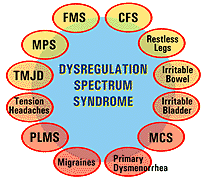Overlapping Conditions
Overlaps with Fibromyalgia
Fibromyalgia syndrome (FMS), chronic fatigue syndrome (CFS), multiple chemical sensitivity syndrome (MCS), myofascial pain syndrome (MPS), and other conditions form a family of overlapping syndromes. In fact, researcher Muhammad Yunus, M.D., of the University of Illinois College of Medicine, claims, most patients have more than one syndrome. Thus, he views FMS and CFS as being part of a larger spectrum of conditions, which he calls Dysregulation Spectrum Syndrome or DSS (see diagram below). Dr. Yunus uses the term dysregulation to mean biophysiological abnormalities, possibly in the body's neurological, hormonal and chemical systems.

Backing up Dr. Yunus’ commentary are studies by Dedra Buchwald, M.D., of the University of Washington, Anthony Komaroff, M.D., of Brigham and Women’s Hospital and Don Goldenberg, M.D., of Newton-Wellesley Hospital. It is always important to keep these overlapping syndromes in mind because the presence of one or more syndromes could impact your treatment. These three researchers have shown that CFS and FMS overlap in patients by as much as 75%. When it comes to MCS, this syndrome is present in roughly 50% of FMS- and CFS-diagnosed patients.
Most practicing physicians and researchers alike will tell you that the chronic pain diagnosis a person first receives is often colored by their chief symptom complaint. For example, widespread muscular pain is often diagnosed by rheumatologists as fibromyalgia syndrome. A person who is overcome by extreme fatigue and flu-like symptoms might consult an infectious disease expert and receive the diagnosis of chronic fatigue syndrome. A person who has severe jaw pain might see a dentist and be told that they have temporomandibular joint dysfunction (TMJD). People who appear to have allergic-type symptoms to a number of chemicals, foods, or odors may be informed by an allergist that they have MCS. Similar situations occur with the other conditions in the family of Dysregulation Spectrum Syndrome.
Sleep Disorders in Fibromyalgia
Two common sleep disorders that may be present in fibromyalgia patients are: restless leg syndrome (RLS) and periodic limb movement during sleep (PLMS). According to sleep researcher Harvey Moldofsky, M.D., of the University of Toronto, RLS has been described as someone playing soccer all night long. The patient’s arms and legs just cannot stay still. PLMS may feel like a startling response that occurs when you think you have reached the last step going down a flight of stairs and you fling your limbs to catch your balance as you discover that there is one step remaining. Both RLS and PLMS can cause continuous arousal movements during sleep and impede your ability to wake up feeling rested.
Referring to the specific sleep disorders of RLS and PLMS, Dr. Yunus comments that a sleep study might be helpful if a physician suspects either condition. First of all, it may offer an objective test finding that is lacking for most fibromyalgia patients. Secondly, the treatment for RLS or PLMS is a benzodiazepine with anti-seizure properties such as Klonopin (clonazepam), or a dopamine-like drug such as Mirapex or Requip. The most commonly used medications for fibromyalgia, such as tricyclics like Elavil and trazodone, can actually make this subgroup (30%) of patients worse. Therefore, it is important that you assist your physician by providing accurate symptom information regarding your sleep to help identify related syndromes. This can aid in the development of appropriate treatment strategies.
Could fibromyalgia be part of a newly discovered sleep disorder?
Novel findings are continuing to shape the direction of research and theories about the cause of these overlapping syndromes. In the October 2004 issue of the Fibromyalgia Network Journal, a recently identified sleep disorder was found in 27 of 28 fibromyalgia patients tested. Is this just a fluke or could a disruption of sleep truly be the origin of your symptoms? Jed Black, M.D., Medical Director of Stanford's Sleep Clinic addresses this topic in the January 2006 issue of the Fibromyalgia Network Journal. To read about answers to new and intriguing questions, become a Member of Fibromyalgia Network. As new research discoveries are presented by scientists in the field, you can rely upon Fibromyalgia Network to cover them! To join, call (800) 853-2929, or click here to become a Member online.
«Symptoms | «Criteria for Diagnosis | «Treatment | »Research

